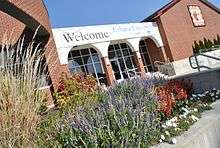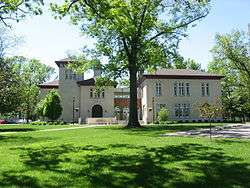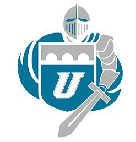Urbana University
 Urbana University Student Center | |
| Type | Private |
|---|---|
| Established | 1850 |
| Provost | Dr. Christopher Washington |
Academic staff | 52 |
| Students | 1,505 |
| Location |
Urbana, Ohio, United States 40°06′02″N 83°45′36″W / 40.1005556°N 83.76°WCoordinates: 40°06′02″N 83°45′36″W / 40.1005556°N 83.76°W |
| Campus | 128 acres (0.52 km2) |
| Colors | Blue and White |
| Athletics | 14 varsity teams |
| Nickname | Blue Knights |
| Affiliations |
Division II MEC |
| Mascot | Knitro the Blue Knight |
| Website | www.urbana.edu |
Urbana University, a branch campus of Franklin University, is a private university specializing in liberal arts education. Urbana is located in Urbana, Ohio, in Champaign County, approximately one hour west of Columbus and one hour northeast of Dayton.
History
Urbana University was founded in 1850 by followers of the 18th century Swedish philosopher and scientist, Emanuel Swedenborg. The university was the second institution of higher learning in Ohio to admit women; the first was Oberlin College. The groundwork for the founding of the university was in part laid by John Chapman, better known as Johnny Appleseed, who became the inspiration for the Johnny Appleseed Museum founded for his extraordinary history. While more famous for spreading apple seeds throughout the East, Chapman was also a Swedenborgian missionary and helped spread this faith among the early settlers around Urbana.[1] Chapman encouraged his friend and fellow Swedenborgian, John Hough James, to donate the land on which Urbana University was built.[1] To this day, the University maintains an informal relationship with the Swedenborgian General Convention of the Church of the New Jerusalem in the United States of America.[1] The university is also home to the Johnny Appleseed Educational Center & Museum to honor John Chapman.[2]
Classes for elementary and secondary students under the name Urbana Seminary began in the fall of 1850 in a rented room in a building in downtown Urbana.[1] College level classes were first held in the fall of 1854, following the construction of Bailey Hall, the first building on the campus.[1] Less than 10 years after the college opened it suspended operations from 1861-1866 during the Civil War.[1] The college experienced a number of changes in the early 20th century when the college's curriculum was shortened to a two-year junior college format in 1907.[1] The school later shut down the primary school in 1911; and the secondary school was closed in 1928.[1]
Urbana operated as a two-year college until 1968, when it returned curriculum to a four-year format.[1] In 1975, Urbana was granted full membership in the North Central Association of Colleges and Secondary Schools.[1] In 1985, the institution changed its name from Urbana College to Urbana University.[1] Today, in addition to being a traditional liberal arts college, Urbana University's School of Adult and Graduate Education offers associate degree and Bachelor of Science degree completion programs in Business Management, Education, Criminal Justice Leadership, Human Services Leadership, and many more. In addition to these programs, Master's programs are available in Business Administration, Education, Nursing, and Criminal Justice. Classes meet on the Urbana University main campus, and at several off-campus locations throughout Western Ohio. These locations are in Bellefontaine, Dayton, Kettering, Marysville, Piqua, and Springfield.[3]
In 2014, the university was purchased by Franklin University after undergoing significant budget shortfalls.[4] Under the agreement, Urbana would retain its name, and act as a physical campus for both Urbana and Franklin students.[4] On August 1, 2017, Franklin University received approval for its change of status application by the Higher Learning Commission (HLC) to bring Urbana University under Franklin’s accreditation as a “branch campus.”
Campus

The 128-acre (51.8 ha) main campus is located on the southwest side of Urbana in west central Ohio. Its buildings range from historic 19th-century buildings styled in traditional architecture to modern structures. Bailey Hall, Oak Hall, and Barclay Hall are the three oldest buildings on the campus. All three are listed on the National Register of Historic Places.[5] The university has undergone various changes in the early 21st century with the construction of Sycamore Hall in 2004, the Urbana University Stadium,[6] the Student Center in 2006, and McConnell Hall in 2007.[7]
Academics
Urbana University offers 28 undergraduate majors and Graduate programs in Nursing (MSN), Education (MEd), Business Administration (MBA), Criminal Justice Administration (MA), and a Post-Baccalaureate in Teacher Licensure[8]
Athletics

Urbana's athletic teams are known as the Blue Knights, the colors are blue and white. The school sponsors 21 intercollegiate teams. The university is a member of the National Collegiate Athletic Association (NCAA) at the Division II level. Urbana was an independent member of Division II, after completing the transition from the National Association of Intercollegiate Athletics (NAIA) and member of the American Mideast Conference (AMC) to NCAA in 2010.[9] In 2010, the Great Lakes Valley Conference (GLVC) accepted Urbana as associate member of the GLVC in football only starting with the 2012 season.[10]
In 2011, the university and five other schools, many also transitioning to the NCAA from NAIA, announced their intentions to form the Great Midwest Athletic Conference (G-MAC) in 2013.[11] The G-MAC ultimately launched a year earlier than planned, in 2012, with Urbana as a member. The school will spend only one season in the G-MAC; on August 20, 2012, Urbana was unveiled as a charter member of the Mountain East Conference (MEC), a new Division II conference set to launch for the 2013–14 school year.[12] The MEC is mostly made up of schools leaving the West Virginia Intercollegiate Athletic Conference, but also includes another Ohio school in Notre Dame College.[12]
Men's
|
Women's
|
Urbana University also offers club sport programs in Shooting Sports, Bowling, and Cheerleading
Student life
Student Organizations
Urbana University has several recognized student organizations including leadership groups such as Student Government Association, Campus Activities Board, and Student Athlete Advisory Committee. There are organizations with special interest topics around politics, disc golf, and cancer awareness; and there are academic groups for history students and students interested in social sciences.
Residence Life
There are six residence halls on campus (South, East, Francis E. Hazard, McConnell, Sycamore, Ross, and Hickory Halls). Urbana's residence halls emphasize civic responsibility, mutual respect, mature interpersonal relationships, multicultural understanding, and community engagement. Students living on campus forge friendships that last a lifetime while learning about different cultures, backgrounds and ideas, gaining an understanding of being part of a community, and developing their leadership skills. Residential living provides students with life skills which are transferable to careers and other aspects of independent living after graduation. Advice and guidance are available from trained upperclass student resident assistants and undergraduate hall directors. Resident assistants live on each floor of each residence hall and serve as a resource for students dealing with any type of issue. The University's Student Conduct programs were recognized as Ohio's most innovative Student Affairs program in 2014 by the Ohio College Personnel Association.[13]
Alumni
- T. Coleman DuPont, former president of DuPont industries and former U.S. Senator from Delaware
- Justin Edwards, football player; professional mixed martial artist for the UFC's Lightweight Division[14]
- Graham Fach, Professional Bowlers Association, first Canadian to win a PBA Tour title[15]
- Filip Filipović, former NFL player
- Jan Finney, softball player; professional MMA fighter
- Eric Jones, player with the Harlem Wizards
- Karen LaRoe, former president of the West Virginia University Institute of Technology
- Marcus Lewis, NFL player for the Pittsburgh Steelers, the Cincinnati Bengals, and the Detroit Lions
- Ross McGregor, member of Ohio House of Representatives
- Emily Taylor, founder of the Office of Women in Higher Education at the University of Kansas and elected as the president of the National Association of Commissions of Women (1975-1977)
- Gretchen Worden, known for her contributions to the Mütter Museum and several appearances on The David Letterman Show
References
- 1 2 3 4 5 6 7 8 9 10 11 "History of Urbana University". Urbana University. Retrieved October 23, 2011.
- ↑ "National Apple Museum". Johnny Appleseed Educational Center and Museum. Retrieved August 4, 2012.
- ↑ "Off Campus Site Locations", Urbana University
- 1 2 Binkley, Collin (April 30, 2014). "Franklin University buys financially troubled Urbana University". Columbus Dispatch. Retrieved June 18, 2014.
- ↑ National Park Service (2009-03-13). "National Register Information System". National Register of Historic Places. National Park Service.
- ↑ "New Field Stadium for Urbana University". The Motz Group. Archived from the original on 2012-03-30. Retrieved October 23, 2011.
- ↑ "Residence Halls". Urbana University. Archived from the original on 2011-05-01. Retrieved October 23, 2011.
- ↑ "Academics". Urbana University. Retrieved October 23, 2011.
- ↑ Staff (July 9, 2010). "NCAA grants Urbana University full membership". Urbana Daily Citizen. Retrieved October 23, 2011.
- ↑ Billing, Greg (October 7, 2010). "Central State, Urbana football join GLVC". Dayton Daily News. Retrieved October 23, 2011.
- ↑ Jablonski, David (October 17, 2011). "Urbana, Cedarville join Great Midwest Athletic Conference". Springfield News-Sun. Retrieved October 23, 2011.
- 1 2 Rine, Shawn (August 20, 2012). "Cards, Toppers Set To Jump into New League". The Intelligencer & Wheeling News Register. Wheeling, WV. Retrieved August 21, 2012.
- ↑ "Ohio College Personnel Association - Awards". Retrieved December 15, 2016.
- ↑ "Justin Edwards UFC Bio". Retrieved December 15, 2016.
- ↑ "Graham Fach | PBA.com Bio". Retrieved December 15, 2016.